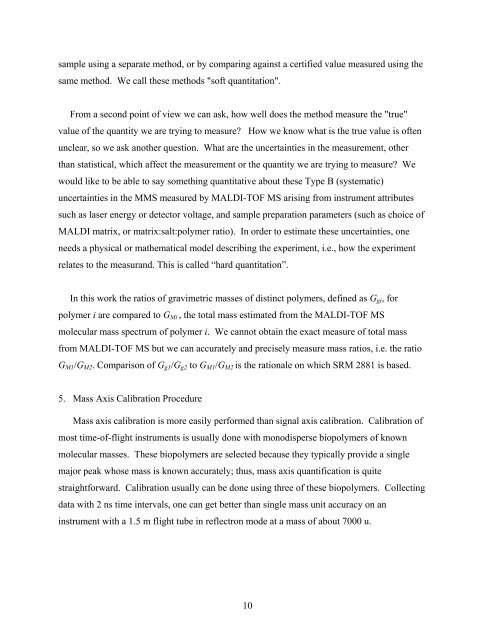Standard Reference Material 2881 - National Institute of Standards ...
Standard Reference Material 2881 - National Institute of Standards ...
Standard Reference Material 2881 - National Institute of Standards ...
You also want an ePaper? Increase the reach of your titles
YUMPU automatically turns print PDFs into web optimized ePapers that Google loves.
sample using a separate method, or by comparing against a certified value measured using thesame method. We call these methods "s<strong>of</strong>t quantitation".From a second point <strong>of</strong> view we can ask, how well does the method measure the "true"value <strong>of</strong> the quantity we are trying to measure? How we know what is the true value is <strong>of</strong>tenunclear, so we ask another question. What are the uncertainties in the measurement, otherthan statistical, which affect the measurement or the quantity we are trying to measure? Wewould like to be able to say something quantitative about these Type B (systematic)uncertainties in the MMS measured by MALDI-TOF MS arising from instrument attributessuch as laser energy or detector voltage, and sample preparation parameters (such as choice <strong>of</strong>MALDI matrix, or matrix:salt:polymer ratio). In order to estimate these uncertainties, oneneeds a physical or mathematical model describing the experiment, i.e., how the experimentrelates to the measurand. This is called “hard quantitation”.In this work the ratios <strong>of</strong> gravimetric masses <strong>of</strong> distinct polymers, defined as G gi , forpolymer i are compared to G Mi , the total mass estimated from the MALDI-TOF MSmolecular mass spectrum <strong>of</strong> polymer i. We cannot obtain the exact measure <strong>of</strong> total massfrom MALDI-TOF MS but we can accurately and precisely measure mass ratios, i.e. the ratioG M1 /G M2 . Comparison <strong>of</strong> G g1 /G g2 to G M1 /G M2 is the rationale on which SRM <strong>2881</strong> is based.5. Mass Axis Calibration ProcedureMass axis calibration is more easily performed than signal axis calibration. Calibration <strong>of</strong>most time-<strong>of</strong>-flight instruments is usually done with monodisperse biopolymers <strong>of</strong> knownmolecular masses. These biopolymers are selected because they typically provide a singlemajor peak whose mass is known accurately; thus, mass axis quantification is quitestraightforward. Calibration usually can be done using three <strong>of</strong> these biopolymers. Collectingdata with 2 ns time intervals, one can get better than single mass unit accuracy on aninstrument with a 1.5 m flight tube in reflectron mode at a mass <strong>of</strong> about 7000 u.10
















